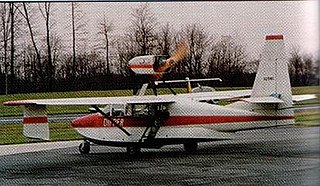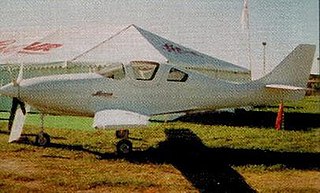
The Lancair IV and IV-P are a family of four-seat, low-wing, retractable-gear, composite monoplanes powered by a 550 cubic inch Continental TSIO-550 twin-turbocharged piston engine.

The Lancair ES is an American amateur-built aircraft that was designed and produced by Lancair. While it was in production the aircraft was supplied as a kit for amateur construction.

The MacFam Cavalier is a homebuilt aircraft designed by Stan McLeod, developed through a progressing series of models, all using all-wooden construction. The model range includes the SA102, SA102.5, SA103, SA104 and the SA105.

The KIS TR-4 Cruiser is a four place composite homebuilt aircraft design.
The Harmon Der Donnerschlag is an American homebuilt aircraft that was designed and produced by Harmon Engineering of Howe, Texas. The aircraft was intended for amateur construction.
The Rogers Sportaire is an American homebuilt aircraft that was designed David M. Rogers and produced by Rogers Aircraft of Riverside, California, introduced in 1959. The aircraft was supplied in the form of plans for amateur construction, but plans are no longer available. Only one was built.
The Amax Vixen 105 is an Australian homebuilt aircraft that was designed and produced by Amax Engineering of Donvale, Victoria. When it was available the aircraft was supplied as a kit for amateur construction.
The Associated Air Liberty 181 is an American homebuilt aircraft that was designed and produced by Associated Air of Woodland, Washington, introduced in the late 1990s. When it was available the aircraft was supplied as a kit for amateur construction.

The Collins Dipper was an American homebuilt flying boat that was designed and produced by Collins Aero of Chadds Ford, Pennsylvania and first flown in 1982. The aircraft was supplied in the form of plans for amateur construction. Only one was built and none remain registered.
The Historical P-51 Mustang is an American homebuilt aircraft that was designed and produced by the Historical Aircraft Corporation of Nucla, Colorado. The aircraft is a 62.5% scale replica of the original North American P-51 Mustang and when it was available was supplied as a kit for amateur construction.

The Lancair Tigress was an American homebuilt aircraft that was designed by Lance Neibauer and intended for production by Lancair of Redmond, Oregon. Introduced in mid-late 1990s, it was essentially a Lancair IV with a much more powerful engine. When the engine was cancelled just as it was entering production, the Tigress project ended with it. Only prototypes were produced.
The Redfern Nieuport 17/24 is an American homebuilt aircraft that was designed by Walter Redfern and produced by the Walter Redfern Company of Post Falls, Idaho, based upon the First World War Nieuport 17 and Nieuport 24 fighter aircraft. When it was available the aircraft was supplied in the form of plans for amateur construction.
The St Croix Pietenpol Aerial is an American homebuilt aircraft that was designed by Chad and Charles Willie and produced by St Croix Aircraft of Corning, Iowa, first flown in 1977. When it was available the aircraft was supplied in the form of plans for amateur construction, with partial kits available.
The St Croix Pietenopol Aircamper is an American homebuilt aircraft, an adaptation of the classic 1920s Pietenpol Air Camper, re-designed by St Croix Aircraft of Corning, Iowa. When it was available the aircraft was supplied as a partial kit and in the form of plans for amateur construction.
The St Croix Sopwith Triplane is an American homebuilt aircraft that was designed and produced by St Croix Aircraft of Corning, Iowa. When it was available the aircraft was supplied as a kit or in the form of plans for amateur construction. The aircraft is a full-size replica of the 1916 Sopwith Triplane fighter aircraft.
The Starfire Firebolt, sometimes called the Starfire Firebolt Convertible, due to its removable canopy, is an American homebuilt aerobatic biplane that was designed by G. H. "Mac" McKenzie and produced by Starfire Aviation of Tempe, Arizona. When it was available the aircraft was supplied in the form of plans for amateur construction, with some pre-fabricated parts available.

The Warner Revolution II, also marketed as the Space Walker II, is an American homebuilt aircraft that was designed and produced by Warner Aerocraft of Seminole, Florida. When it was available the aircraft was supplied as a kit or in the form of plans for amateur construction.

The Specter Aircraft Specter II was an American homebuilt aircraft that was designed and produced by Specter Aircraft of Bancroft, Idaho, introduced in 1997. When it was available the aircraft was supplied as a kit for amateur construction.
The Ibis GS-750 Grand Magic is a Colombian homebuilt aircraft, designed and produced by Ibis Aircraft of Cali, introduced in 2006. The aircraft is supplied as a complete ready-to-fly-aircraft or as a kit for amateur construction.
The Lancair Sentry is an American amateur-built aircraft that was designed and produced by Lancair of Redmond, Oregon, introduced in 2002. The aircraft was supplied as a kit for amateur construction, although it was also intended as a production military trainer aircraft. First flown in September 2001, only two were ever completed.











